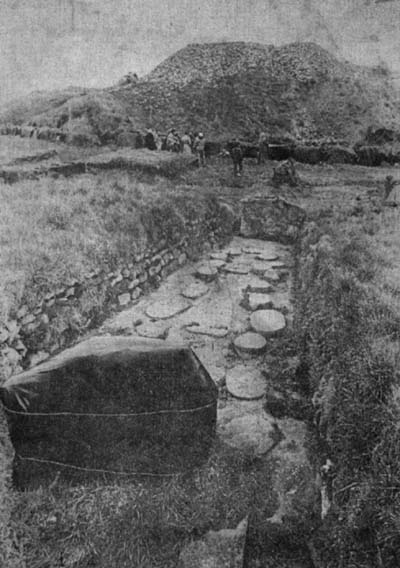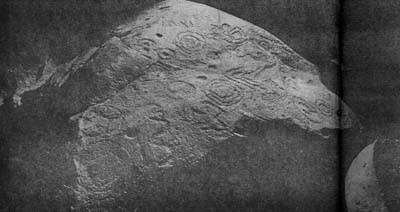 |
||
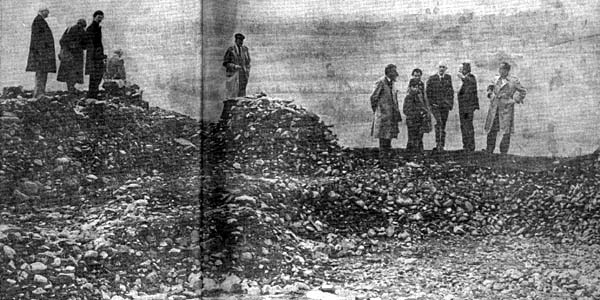
A section of the group examining recent cuts at the summit of the main mound.
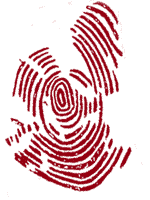 About Stonelight 
Members of the Committee for Archaeology of the European Science Foundation examining |
Expert warns of threat to ancient monuments
By Ella Shanahan, photos by Pat Langan - Printed in The Irish Times 10 April 1984 Unless a comprehensive State archaeological service is provided, few of our ancient monuments will be left by the end of the century, Professor George Eogan, Professor of Archaeology at University College, Dublin, believes. He says we have lost literally thousands of monuments and thousands of artefacts but we still have a lot of visible monuments, although much fewer than we had 20 years ago. "The destruction is at such a rate that unless we have a proper service set up, there won't be much left by the end of the century," he says. Legisation for archaeology is 102 years old. "It's about as out of date as it could be," he says. At the moment, responsibility for ancient monuments rests with the Office of Public Works and the responsibility for artefacts with the Department of the Taoiseach. "We need a unified service. Changes in legislation won't be enough. What you need is a whole change in the attitude by the State. I am sorry to say this wouldn't be innovative: the Swedes reached this situation 300 years ago." Last weekend, following the publication of his major work, "Excavations at Knowth", Professor Eogan took a group of 13 European scientists and archaeologists to the Neolithic settlements of Brugh na Boinne Knowth, Dowth and Newgrange. "They were struck by the variety and wealth of the Irish material and the fact that a lot of research is going on, on the Irish material," he reports. "They were struck by the archaeological and engineering skills of the Neolithic people. The Germans commented a great deal on Tara, which is a great complex of earthworks in such a small area. They commented on similarities in general of the site which reminded them of the great Celtic townships of the Central European area. Professor Eogan was able to show them one of the major treasures of the Knowth excavation about which he has not yet written: the large stone basin found in the Eastern tomb. The basin, measuring four feet across, is a rough piece of sculpture and highly decorated. It appears to be similar to one found by a Professor Molyneux in the 18th century, which has disappeared since. "It indicates that the standard of hewing out of a solid block of stone was something these passage builders were able to do," he says. Professor Eogan says the scientists could see for themselves the beginnings of science at the Co Meath site. The Neolithic people knew that the green grit stone was the best surface for decoration, the beginning of geology. And they observed the sun over long periods, the beginning of heliology. The group was comprised of members of the European Science Foundation, which has members in all EEC countries, as well as Scandinavia, Yugoslavia and Turkey.
|
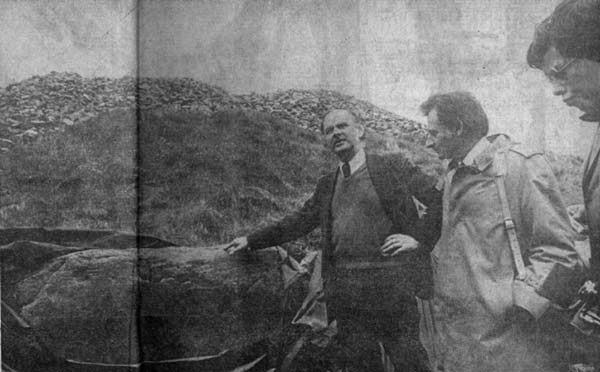
Professor George Eogan, whose volume on the 22-year long excavations at Knowth
has just been published, explains a point to some of the group.
Boyne Valley Private Day Tour Immerse yourself in the rich heritage and culture of the Boyne Valley with our full-day private tours.
Visit Newgrange World Heritage site, explore the Hill of Slane, where Saint Patrick famously lit the Paschal fire.
Discover the Hill of Tara, the ancient seat of power for the High Kings of Ireland.
Book Now
Immerse yourself in the rich heritage and culture of the Boyne Valley with our full-day private tours.
Visit Newgrange World Heritage site, explore the Hill of Slane, where Saint Patrick famously lit the Paschal fire.
Discover the Hill of Tara, the ancient seat of power for the High Kings of Ireland.
Book Now
|
